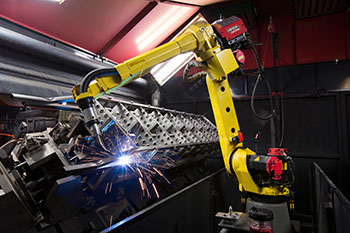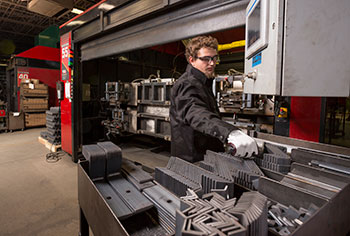Design Strategies for Mobile Robotic Cells
by Richard Stokes, Application Engineer
What Every Fab Shop Needs to Know About Planning, Design and Execution
With ever-increasing demand on manufacturers to produce a broad array of high-quality products that remain competitive in the marketplace, the need to automate production processes has never been greater. Short product lifecycles coupled with diverse product portfolios creates a high product-mix, low-volume scenario that is increasingly driving small- and medium-sized enterprises to invest in robotic automation technologies. As production demands increase, providing hand-made solutions to a customer is becoming less viable. Automation is no longer an option - it has become a necessity.
The need to maximize the functionality of their capital investment means companies are constantly looking for ways to make systems as flexible as possible. This often is in the form of specially designed tooling and fixturing that can be changed out between production runs of different products – the so-called ‘picture-frame’ assembly, which has a permanently mounted frame inside the positioner and modular fixtures can be mounted and dismounted when required.
The true challenge arises when they need to move entire robotic cells from one area of a facility to another, or even to another facility altogether, to keep pace with the demands of an ever-changing production environment.

Two main driving forces behind the push to automate are increasing system throughput and maintaining consistent, high quality. Thus, most tasks performed by a robot are repetitive in nature, do not change over time, and have short cycle times in order to maximize system throughput.
Very large robotic cells and production lines involving multiple mechanical units are generally not easy to relocate to other areas in a facility or between facilities that are geographically separated.
Such a move involves many costs: labor, utilities, freight, re-installation, re-programming or re-commissioning, and operator training to name just a few. In addition, building a system to account for multiple unknowns means building in redundancy to accommodate this flexibility, which adds to the cost of the system.
In most cases when a robotic manufacturing system needs to be moved, particularly between remote sites, the cost of the move can be a significant percentage of the original cost of the system. In these cases, a more economically viable solution would be to apply those relocation costs to a new system. However, with careful planning and preparation, manufacturers can build systems specifically designed to be relocated according to changing production schedules and demands.
So what are small- and medium-sized manufacturers to do when it comes to specifying and installing a system that one day will need to be moved? The answer’s easy: Think modular.
Building a robotic cell with the necessary flexibility to allow the manufacture of a diverse range of products within different areas of a facility or even geographically separate facilities is a design decision that must be addressed early in the planning cycle. A clear understanding of the product mix, production system flow and how best to achieve the desired return-on-investment are critical factors to the system design phase.
Fabricators that must deliver optimal part flow now, yet retain the ability to adapt to future product-mix changes, should consider the advantages of modular work areas from the start of the planning and design phase. It isn’t something that can be adjusted easily at the time of installation.
The ideal flexible solution is small, self-contained and adaptable, with any necessary positioners and fixtures located within the robot’s work envelope. Instead of a work area that is always dedicated to the same task, the robot’s entire work area is a modular unit that can be swapped out to accommodate any type of device, from simple tables and clamping units to headstocks and small multi-axis positioning units.
With this flexibility, however, comes an added cost during the system design phase. The ability to swap out system components and/or include advanced features that simplify moving the cell to a different location involves added engineering costs.
Due diligence, therefore, must be taken in order to ascertain whether or not the required return can be made on the additional initial cost within the required timeframe, especially since the high product mix/low volume situations typically have a lower rate of return due to the additional time required for start-up and commissioning (part programming) and lower overall part count. For some companies with more stringent capital expenditure requirements, the additional engineering and production benefits such an approach offers can be challenging to define purely in financial terms. In this case, it might be better - and less costly - to install additional dedicated cells in lieu of a modular solution. There are, however, other, more economical mobile options.
Self-contained palletized units that center on a fixture already located inside the work envelope present another alternative, if cost is a factor. Larger units can be broken down into smaller components and shipped in parts. Some of the palletized cells are even designed with special, built-in receptacles to enable movement via forklift. When designed efficiently, they can simply be unplugged, lifted and dropped on a truck for relocation.
If cell mobility is the end goal, either a modular or palletized solution works toward addressing the needs of a high-mix production facility, but there are trade-offs between lower cost (palletized) vs. building redundancy and flexibility (modular) into a system.
Keep It Simple When a robotic cell does need to be moved, shops can take steps to streamline the process. Moves never should be made on the fly, but rather be planned in advance.
For example, whether using modular cell components or a palletized system, shops must make sure upfront that the units are built with quick disconnects for electric and air to enable rapid removal from the utility grid. Gas bottles mounted directly on the units avoid the need to locate the cell near a central gas connection. Use local wire-delivery solutions, such as Lincoln Electric’s Accu-Pak® boxes and drum reels, to eliminate the need for connection to a remote wire source. Also consider using local fume-extraction units if there is no central system available in the shop. Portable air circulators will accommodate multiple cells.
Safety also plays a big consideration in a move. Many modern robotic cells have integral safety systems that are compliant with Robotics Industries Association standards. No additional safety items are required when these units are moved around a facility or between locations.
When moving a robotic cell, remember that robots do not possess human-like intelligence with the ability to reason. Every robot movement must be programmed by a person. When moving a cell, mechanical components can flex and move, especially when swapping out tooling.
A program that runs flawlessly in one location may have significant error in another location due to the inherent slack in mechanical systems. Fortunately, modern industrial robots have several technologies available to overcome these problems. These can be simple programming constructs or sophisticated sensing technologies that allow the robot to determine and react to changes in the local physical environment.
For example, a user can perform a 3D shift on a program to account for fixture displacement during travel, or even define special program frames attached to a fixture. This requires a skilled robot programmer to access the robot program directly and perform these operations. Instead of investing in very expensive and complicated tooling for part locating, other technologies exist that allow a robot to perform these tasks autonomously.
Touch sensing allows the robot to use either the tip of the wire or a laser sensor to detect basic features on a part and make necessary adjustments to its program. While this is relatively easy to program a robot to do, it can add to the overall cycle time of the robot. A faster solution that requires more programming time during commissioning is to use a camera on the end of the robot. FANUC® Robotics’ 2D and 3DL iRVision® platforms provide an extremely powerful feature set that deliver one of the most flexible solutions available. With this system, a robot can literally see the world around it, and can easily perform tasks such as part detection, part recognition, feature detection, program offset, and can even detect which type of fixture or tool is loaded in its work area.
The most effective tool at a system designer’s disposal is CAD (Computer Aided Design). By making extensive use of 3D modeling software in the system design phase, one can literally see what a system will look and perform like when it is built. At Lincoln Electric, design engineers make extensive use of DELMIA® for designing cell layouts and performing reach analysis. Once a system is built, it can be programmed offline and programs can be verified using FANUC Robotics’ proprietary RoboGuide® suite of applications, ensuring maximum uptime and effectiveness for a system.
Planning for the future
Fundamentally, developing a successful strategy for mobile robotic cells is a design and planning challenge. Not only must manufacturers develop the solution for today’s product portfolio, but anticipate future demands. Thus, it is critical to build redundancy and flexibility into a system to create the most versatile and, ultimately, mobile solution.
As discussed, because flexibility and redundancy have definite costs, fabricators need to ask this: “Do we want to invest upfront in a flexible solution that most definitely will grow and adapt with our shop or do we want to amortize such costs by selecting a less-expensive, fixed robotic solution?” This decision must be determined during the design phase because, while flexibility is expensive on the front end, retrofitting a cell down the road can be even more costly. It requires a holistic approach that examines the entire production process to determine the ultimate return on investment.
The best way to approach this problem is to look at the processes and procedures currently in place and then determine what processes you want the automated solution to improve. The proposed solution must not only make economic sense, but must also fit in with current and anticipated production requirements. As the field of robotics continues to evolve, so will the tasks to which they are assigned.
Richard Stokes is an application engineer with Lincoln Electric’s Automation Division. He moved to the United States from New Zealand in 2011 and holds a bachelor’s degree in Mechatronics.

